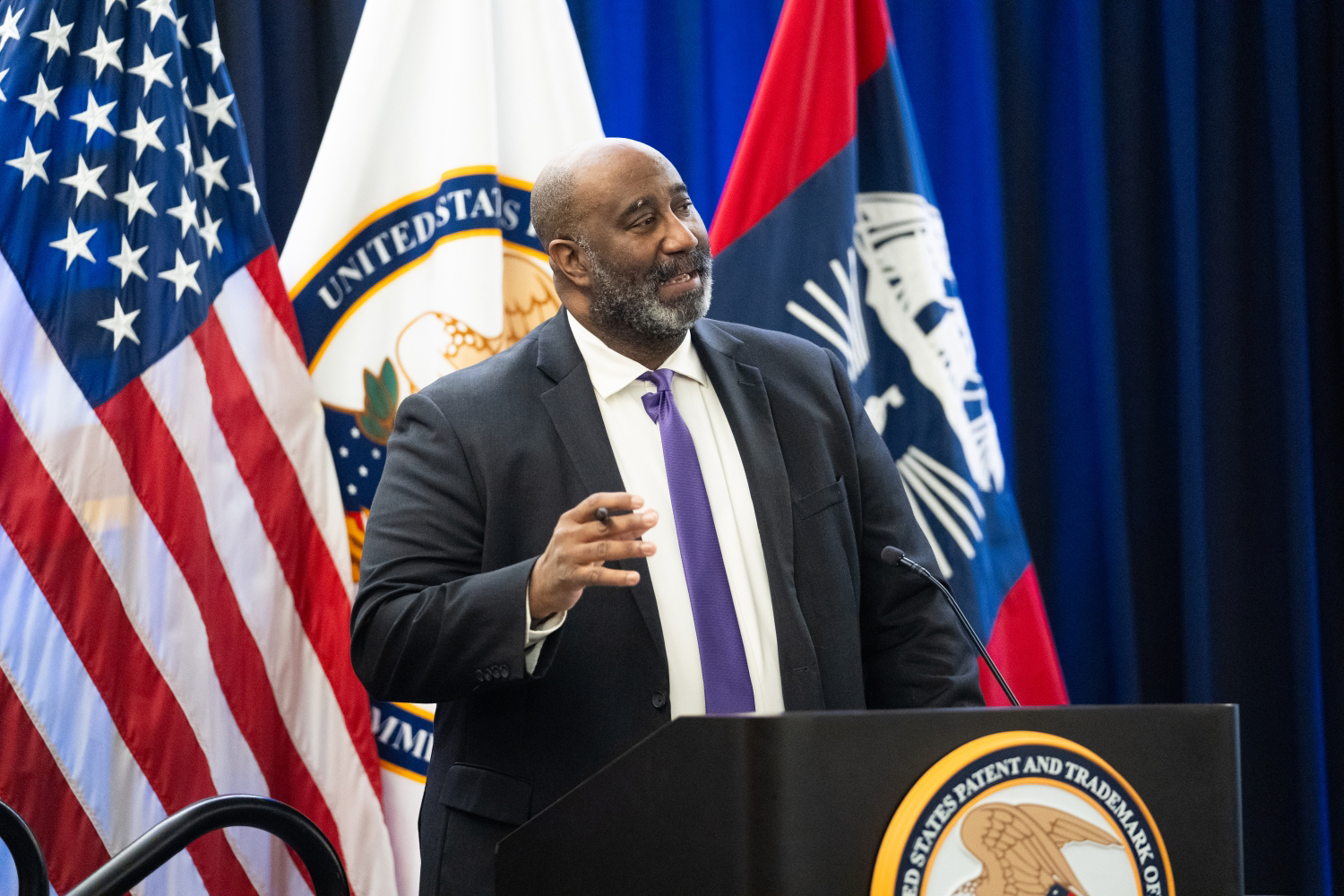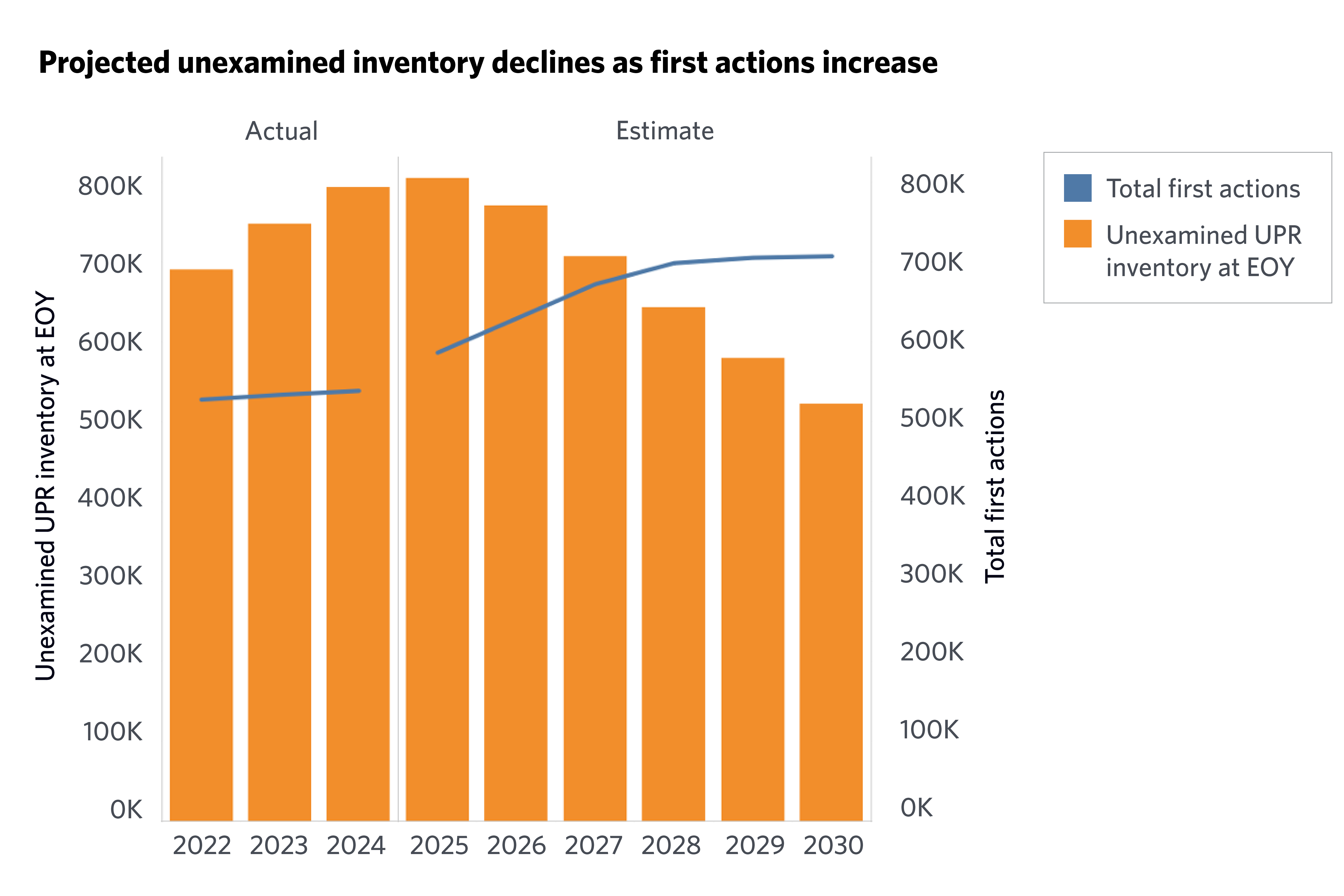
https://www.uspto.gov/blog/patent-pendency-goals-road-map-future
Content Reproduced verbatim from the Website of the United States Patent & Trademark Office as permitted under their Terms of Use.

Acting Director Derrick Brent speaks before signing a collective bargaining agreement between the USPTO and National Treasury Employees Union Chapter 243 at the agency’s headquarters in Alexandria, Virginia, on January 15, 2025. (Photo by Michael Connor/USPTO)
At America’s Innovation Agency, we recognize the tremendous responsibility and honor we have to examine the hundreds of thousands of patent applications we receive each year, thoroughly and reliably, and to make informed decisions whether each application should receive a patent grant. Patents are a vital part of our country’s economic strength and success. We lead the world in innovation, thanks in no small part to our intellectual property system that fosters new inventions through patents.
Our incredible Patents team, led by Commissioner Vaishali Udupa, is laser focused on doing its part to foster innovation by reducing the amount of time it takes to evaluate patent applications (pendency) while not sacrificing the thorough review that is central to our mission of providing robust and reliable rights.
The team has created a multiyear plan that’s intended to ultimately reduce pendency and inventory to healthier levels, benefiting our stakeholders. While our pendency numbers are likely to increase in the near-term as measures are being implemented and refined, we anticipate these numbers will fall over time to improved levels due to increased examination capacity and process efficiencies.
Focus on first actions
This past fiscal year, one of our Patents team’s top priorities was to develop long-term solutions to reduce pendency and our inventory of unexamined applications. The first focus was increasing the number of first office actions, or the written explanation by a patent examiner that may cite prior art and/or give reasons why the examiner has allowed (approved) and/or rejected the applicant’s claims.
One initiative under this approach was the launch of the One for One award, where we encouraged everyone in Patents to join a collective effort to focus on first actions mailed in new, unexamined applications. The output surpassed the high goal that was set. We mailed 255,000 first office actions during the third and fourth quarters of fiscal year (FY) 2024. This was an increase of almost 18,000 first office actions year-over-year. This success reflects the largest number of first actions since FY 2015.
While we are within statutory deadlines for completing most of our office actions (also known as patent term adjustment – or PTA – compliance) we know we have work to do to ensure all applicants receive timely examination at all stages.
Pendency Oversight Strategy Team
To oversee further pendency improvements, in June 2024 Commissioner Udupa set up the Pendency Oversight Strategy Team (POST).
POST’s goal is to develop and implement a long-term framework and strategy for sustainable pendency improvements. For example, the team is investing in cutting-edge artificial intelligence (AI) tools to improve examination search capabilities and also enhancing our classification and routing processes.
POST is coordinating more than 15 pendency related initiatives that will generate significant gains in reducing pendency over the next five years. You can read about several of these initiatives here, in a recent post to this blog.
Commissioner for Patents Vaishali Udupa speaks at a ceremony of the Supervisory Patent Examiners and Classifiers Organization at the USPTO’s headquarters on November 12, 2024. (USPTO photo)
Hiring
We’re now at an inflection point that requires us to build examination capacity to achieve our long-term pendency goals.
To that end, we’re increasing our corps by hiring and training patent examiners with the technical skills needed to examine applications thoroughly and efficiently. Additionally, we’re enhancing and coordinating our systems to increase retention of examiners. Ensuring we have the capacity and talent to handle our growing innovation system is of paramount importance. (For a recent blog post about our examiner hiring efforts, please read this Q&A with Commissioner Udupa.)
We’re already building momentum.
In FY 2023, we hired 644 patent examiners, and in FY 2024, we hired 969 – exceeding our own goals. So far in FY 2025, we’ve onboarded more than 500 new examiners. We intend to continue recruiting and hiring talented examiners in the future, so that our capacity matches the demand of incoming applications and our inventory.
We recently initiated a referral bonus to help us cast a wide net to find talent. We improved our job announcements to attract the best talent. And we’re enhancing the new examiner experience by piloting a hybrid training program designed to improve the onboarding experience for new employees as well as increasing retention. The first hybrid training class joined the USPTO on January 13, 2025.
And there’s much more to come.
Looking to the future
Our planned emphasis – increasing examination focus on first actions – initially will result in an increase in the volume of first actions we process, particularly first actions on our oldest application inventory.
We’re already seeing results.
First actions increased from about 530,000 units in FY 2023 to nearly 545,000 units in FY 2024. The average number of months from a patent application filing date to when we mailed a first office action was down from 20.5 months in FY 2023 to 19.9 months this past year.
If we effectively execute our hiring plans, along with other efficiency measures to be implemented, our first actions may increase to as high as 585,000 units in FY 2025.
We expect this may cause a short-term decrease in overall PTA compliance for mailed actions (as older inventory first actions mailed will show as decreased compliance for a period of time). But examination output will increase each year and improvements in PTA compliance will follow. We anticipate this will reduce unexamined inventory from 800,000 units in FY 2024 to about 650,000 units by FY 2028, assuming application filings are as projected.
We closed FY 2024 with significant accomplishments that establish a foundation to improve our pendency in a sustainable way. This, alongside our focus on examination quality, will ensure the USPTO continues our unwavering commitment to fostering American innovation, competitiveness, and job growth by providing robust and reliable intellectual property rights.

This chart shows the USPTO’s unexamined inventory of patent applications, with actual numbers in fiscal year 2022-24 and estimates for future years. (USPTO image)
